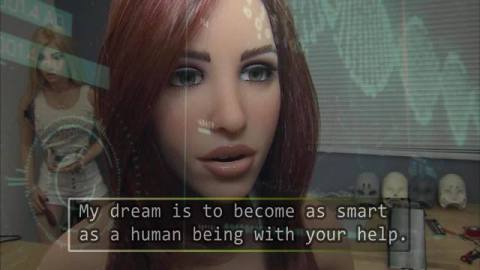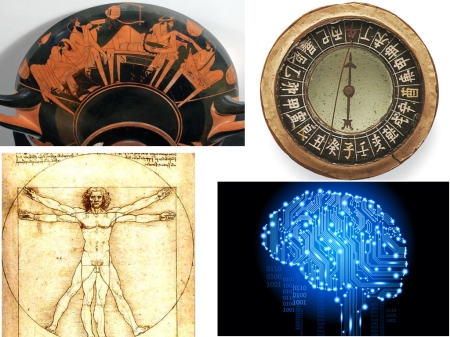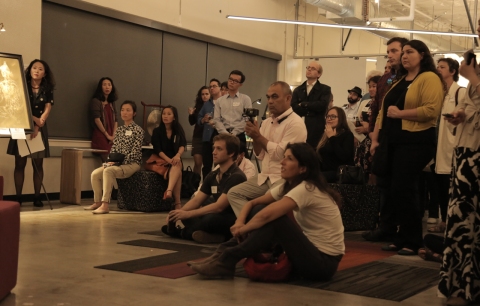Sex Robots, an African Heroine, and the Uncanny Valley (Part 1)
May 26, 2017 § Leave a comment

When I first came across African artist Milumbe Haimbe a couple years ago, thanks to introduction by Cissie Swig, beloved San Francisco art benefactor, her graphic novel “The Revolutionist” was clearly a science fiction. The story is set in the near future on a satellite colony off the orbit of mainland Earth, dominated by a corporation. Social conformity is subliminally reinforced, the economy is purely corporate-driven, exploitation of human by human thrives and the insatiable appetite for sex robots threatens to tip the already delicate social balance. This gives rise to the resistance called Army for the Restoration of Womanhood. The protagonist Ananiya is a special agent in its Covert Operations Division when news spreads that the Corporation is developing a prototype robot that is sophisticated and sexually attractive enough to replace human women altogether. Before long the resistance galvanizes into a full-blown revolution, and Ananiya thrives to become the most unlikely hero on a mission to destruct the prototype before it enters the mass market.
If the story of robots replacing real women sounds far-fetched, I am here to report that Abyss Creations, manufacturer of RealDoll, life-size sex dolls designed to recreate the appearance, texture, and weight of the human form, has launched Harmony AI, bringing artificial intelligence to the dolls the company has been making for 20+ years. “Harmony smiles, blinks and frowns. She can hold a conversation, tell jokes and quote Shakespeare. She’ll remember your birthday, […], what you like to eat, and the names of your brothers and sisters. She can hold a conversation about music, movies and books. And of course, Harmony will have sex with you whenever you want”, as Jenny Kleeman reports for The Guardian after visiting the factory and interacting with the prototype. « Read the rest of this entry »
PULSE | Spring 2017: Science Imagery Oscars, Dementia & Arts, Design in Tech, Innovation Measurement, and the Disruption Myth
March 30, 2017 § Leave a comment
Introducing PULSE: Essinova’s quarterly highlight of insights, news and events at the creative edge across art, science, design, (purposeful) technology, leadership and innovation.
…Tis the Season for Science Imagery Oscars!
(And congratulations Greg and Brian!)
Spring is when both Wellcome and NSF/Popular Science unveil their awards for the best science images, videos and visualizations.
Wellcome Image Awards 2017
The Wellcome Image Awards are Wellcome’s most eye-catching celebration of science, medicine and life. Now in their 20th year, the Awards recognise the creators of informative, striking and technically excellent images that communicate significant aspects of healthcare and biomedical science.
This year’s Wellcome Image Awards were presented on 15 March 2017, celebrating the scientists, clinicians, photographers and artists who bring science to life through remarkable imaging.
Mandarin Leader Award | 名都领袖奖
December 19, 2016 § Leave a comment
 As the year comes to a close, I am honored to share with you that I have been featured as a 2016 Mandarin Leader, an annual award recognizing excellence in North America’s Chinese community! Inaugurated in 2015, Mandarin Leader spotlights exceptionally creative or philanthropic individuals, who, regardless of industry, have “created something out of nothing, taken risks, and exhibited characteristics associated with leadership”.
As the year comes to a close, I am honored to share with you that I have been featured as a 2016 Mandarin Leader, an annual award recognizing excellence in North America’s Chinese community! Inaugurated in 2015, Mandarin Leader spotlights exceptionally creative or philanthropic individuals, who, regardless of industry, have “created something out of nothing, taken risks, and exhibited characteristics associated with leadership”.
I am humbled to be in the company of a cadre of outstanding Chinese leaders in North America making substantive contributions across academia, the arts, business, science, medicine, media, government, non-profits and entertainment. Many thanks to Mandarin Leader organizers for the honor, and for their initiative conducting such a meaningful award showcasing creativity and altruism in the Chinese community!
旧岁将尽之际,很高兴地和您分享一个消息:本人被誉为2016年度“名都领袖”!这一奖项为北美华人社群中的卓越成就者而设, 突出表彰具有创意或致力于公益的个人及组织,“不论职业为何,这些领袖们在各个行业从无到有创造出今日的成果,他们有冒险家精神,还有领导者的特质”。
这些北美杰出华人在学术、商务、艺术、政府、媒体、科学、医学和娱乐等行业有着显著的成就。被列为其中一员,我深感荣幸。感谢“名都领袖”赋予的盛誉,也感谢其组织者引领这一如此有意义的嘉奖, 以弘扬创意与公益。
Illuminating Consciousness, Mindfulness and the Emotional Brain – Dr. Greg Dunn’s talk at Essinova Salon now available on video
November 29, 2016 § Leave a comment
As promised, for those who could not come to our salon and pop-up gallery at SAP Labs a few weeks ago and requested recordings, video of the excellent talk by neuroscientist-artist Dr. Greg Dunn is now available on Essinova website:
几星期前没能到场我们在SAPLabs举办的首届沙龙活动的朋友,曾提出要求观看讲座的录影。我们已将科学艺术家邓恩博士的精彩讲话视频登载在网站上,欢迎观看:
Windhover – a Sanctuary, a Discovery, and a Soaring Spirit
November 23, 2016 § Leave a comment
It has been a rough month. Just when the Windhover is sorely needed.
I stumbled upon the Windhover Contemplative Center at Stanford on a stroll through campus 2-3 years ago, when it was still under construction. Intrigued, I made a mental note to visit, but did not have a chance to do so until last Thursday, thanks to a faculty friend who accompanied me in.
I discovered not only a poetically restorative sanctuary, but also the stunning artworks by Nathan Oliveira, Prof. of Studio Art at the School until his passing in 2010; as well as the inspirational story of the space’s very creation. « Read the rest of this entry »
Weaving New Webs of Art, Science and Innovation: Inaugural Essinova Salon Explores Neural Insights in Multiple Dimensions
October 10, 2016 § Leave a comment

Written by: Timothy McCormick
Essinova’s inaugural salon and popup gallery on Sept 29 was a great success! A capacity crowd of over 100 guests from widely varied backgrounds gathered at SAP’s AppHaus in Palo Alto, to see the groundbreaking work of neuroscientist/artist Greg Dunn, and to hear talks by Dunn and by Janaki Mythily Kumar, SAP’s VP and Head of Design & Co-Innovation Center.

Greg Dunn’s original artworks on display at Essinova Salon and Popup Gallery at SAP Labs. Click to view event photo album.
We were honored to share with new audiences the extraordinary work of Greg Dunn, PhD, Philadelphia-based neuroscientist and leading art+science pioneer, who explores novel and visually stunning methods to depict and explain brain structure and functioning. The salon featured a variety of original works and prints by Dunn, including his latest and perhaps most ambitious work to date, “Self Reflected,” which the artist describes as the most detailed and complex artistic depiction of the brain ever been created .”Self Reflected” was funded by National Science Foundation and is on permanent display at the Franklin Institute in Philadelphia.
The event program was led of with an introduction by BeiBei Song, Founder of Essinova interdisciplinary creativity agency, in which she described a recent serendipitous encounter in Finland with “lights hunters” who travel to view and record Aurora Borealis (Northern Lights) displays. Describing a scientist, adventurer, executive coach, artist and photographer she befriended there, Song suggested how science, art, design and innovation are driven by related mixtures of passion, curiosity, delight, and a determination to question, understand and explain. Understanding these diverse and mingled drives and roles can open us to richer discoveries across all fields, personally and as a society; and give us the more holistic understandings needed for both business and society to evolve sustainably and creatively, she suggested. « Read the rest of this entry »
Essinova首届“创意沙龙暨快闪画廊”在SAP Labs举行:以神经学洞见艺术、科技与创新之跨界探索
October 9, 2016 § Leave a comment
撰文:李汭璇 Ruixuan Li
9月29日晚,由Essinova创灵升畅创意经纪公司主办、SAP Labs 承办的一场跨界活动 “艺术、科技与创新:神经连接 (Art, Science and Innovation:a Neural Connection)” 在位于帕罗奥图市的SAP AppHaus举行,为硅谷的人们带来了一个趣味无穷的艺术与创意的夜晚,邀请工程师、科学家、艺术家、设计师、和创业家齐聚一堂。活动中最大亮点来自神经学家、艺术家格雷格·邓恩(Greg Dunn)博士在现场展示的他最新的微蚀创作。Essinova创始人宋贝贝、邓恩博士以及SAP Labs副总裁贾纳基·库马尔分别在活动中做了精彩的演讲。湾区本土的科技初创公司Spire为当晚的抽奖活动赞助了可穿戴的冥想装置作为奖品。此外,当晚的来宾还参与了SAP Labs精心策划的互动游戏。
邓恩是Essinova旗下的一位签约艺术家。他以神经科学的博士学位毕业于宾夕法尼亚大学,现居费城,全职进行艺术创作。在读研究生的时候, 邓恩就从自己的艺术实验里发现了神经形态与亚洲极简美学(尤其是水墨画与金箔画的表现形式)的惊人相似性。邓恩和另一位同为科学博士的布莱恩·爱德华合作, 发明出了一种叫作“反射微蚀法 (Reflective Microetching)”的革命性技术, 并运用该技术在金箔表面进行动态图像的创作。当晚,邓恩带来的作品都是基于这一项曾经获得过美国国家科学基金会奖金的技术。 « Read the rest of this entry »
The “Big Picture” Wrapup; and a New Chapter for Essinova
September 10, 2016 § Leave a comment

Started as a review of Q1 2016 news reflecting the technology, culture and economics confluence, the Big Picture series has extended well into Q3. In the meantime, world affairs have been taking troubling turns, with one shocking news story after another. The unstoppable Fourth Industrial Revolution, itself complex with mixed implications, is now juxtaposed on top of precarious geopolitical and social dynamics potentially affecting the world at large.
A recent article on these themes particularly resonated with me: “History tells us what may happen next with Brexit & Trump,” by Tobias Stone, entrepreneur, investor, writer and innovation scholar. As with Eric Weiner’s time travel back to Athens for historical insights in The Geography of Genius, Stone’s background in archeology affords him a macroscopic view onto anthropological patterns which enables a more insightful prediction of where the world might be headed. “We humans have a habit of going into phases of mass destruction, generally self imposed to some extent or another,” he says, “and another such stupid season might very well be ahead of us.”
Historical patterns have sobering inevitability, and the bad case scenario could sadly become reality. With hell in Syria, mess in Europe, violence and “Trumpism” in the U.S., terrorists everywhere, and WWIII not inconceivable, let alone ongoing challenges such as climate woes and health crises, it may seem art and creativity are too frivolous or low-priority for solvers of “serious” problems.
Here again, though, history provides vision. As Graham Greene poignantly remarked about Italy, “for 30 years under the Borgias, they had warfare, terror, murder and bloodshed, but they produced Michelangelo, Leonardo da Vinci and the Renaissance.” The Florence as we know it emerged from Black Death that devastated Europe. As one of many paradoxes of the human condition (and as my friend, cultural historian Piero Scaruffi would point out), creativity often spikes in periods of great instability. « Read the rest of this entry »
The Big Picture, V – China’s Creative Economy, Beijing’s Creative Spaces and a Robot Monk
August 19, 2016 § Leave a comment

China’s Creative Economy, through the lens of creative spaces, is the subject of the last installment of our Big Picture series.
- Crowdfunded “Financiers Coffee” Investors’ Club
- Creative Industry Parks
- Non-governmental Museums
- Longquan Temple (and Its Robot Monk)
It was a few days before New Year 2016 when I first heard the word 融合业态 (Rong He Ye Tai)- fusion or convergence of industries – as a latest trend in China. The son of my father’s friend visited San Francisco with his newly-wed wife during the holidays, and I entertained them. I was trying to explain what kind of work I do (or am doing in recent years), and instead of an awkward silence which I thought would ensue, he was unexpectedly turned on by my “explorations between art and science, culture and technology, nature and lifestyle”, a concept I had thought would be too esoteric, convoluted or impractical for anyone in China to care. “融合业态!” He declared, “It’s the ‘in’ thing now!” He went on to tell me how high tech parks are passé now, replaced by creativity and design parks, and cultural incubators; how a real estate or tourist project would get funding more easily, if it had a cultural theme. He urged me to collaborate with the association he was working for, affiliated with the Ministry of Culture.
Sensing my skepticism, he handed me a document a few days later, on red letterhead. It is the State Council 2014 [10] Gazette, on promoting “the integration of cultural creativity and design services with the development of industries”.
I was blown away. The central government is recognizing that the culture industry has the desirable attributes of “high knowledge intensity, high value-add, low energy consumption, and low pollution”, as the country’s economy goes through much-needed transformation. It is encouraging the “deep integration” of culture industries with ‘real’ economy industries such as technology, manufacturing, real estate and retail, as new sources of growth, competitiveness, employment, consumption diversity and higher standard of living. It knows that without culture leading the way, there would be no “Created in China”.
A couple of trips to China in the ensuing months gave me the opportunity to investigate and see with my own eyes. Below I share with you several creative spaces I visited as part of this reconnaissance. It is not a conclusive report on whether the government’s policy is working – much more time and resources would be needed for that – but rather an observation of the physical (and in some cases, business and cultural) environments that creativity is being pursued, along with anecdotal stories. They are not necessarily born out of the Directive – some of these places predated the Gazette by a decade; and the people I spoke to at these places did not necessarily know anything about the policy; but in a uniquely characteristic Chinese way, the Visible Hand of the Government and the Invisible Hand of the Market are certainly at interplay, with the former sometimes directing the latter, while other times shrewdly taking clues and multiplying the latter.
« Read the rest of this entry »
The Big Picture, IV – How about a 21st Century Florence? Or for that matter, a new Hangzhou?
June 10, 2016 § 1 Comment

“Silicon Valley’s continued success depends, ironically, not on some shiny new gizmo but on learning the lessons of history.”
“What jumpstarts a golden age is not necessarily what keeps it going. The good ones manage to change fuel sources midstream. The Renaissance was initially powered by the recovered ancient texts, but the Humanists who discovered them soon generated their own ideas, their own intellectual momentum. Silicon Valley, if it is to survive, needs to find alternative energy sources, new ways of being creative and not simply new creative products.”
– Eric Weiner, Geography of Genius
“History is a mirror for the future!”
– My parents. Or maybe Chinese axiom?
So it appears that the Bay Area has an art scene undergoing transformation, with exodus and influx both at play. My roundup in the last installment of the Series didn’t even include the Stanford Arts District — the one-stop, four-institution arts compound at Stanford University that is quickly ascending in national significance, with three new buildings in three years (at a cost of $235 million), adding to the existing Cantor Arts Center.






